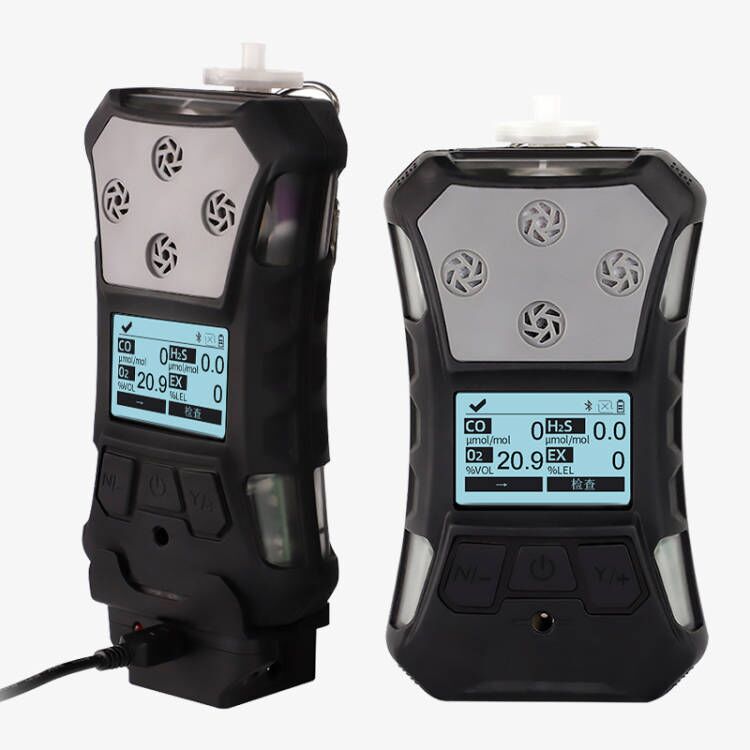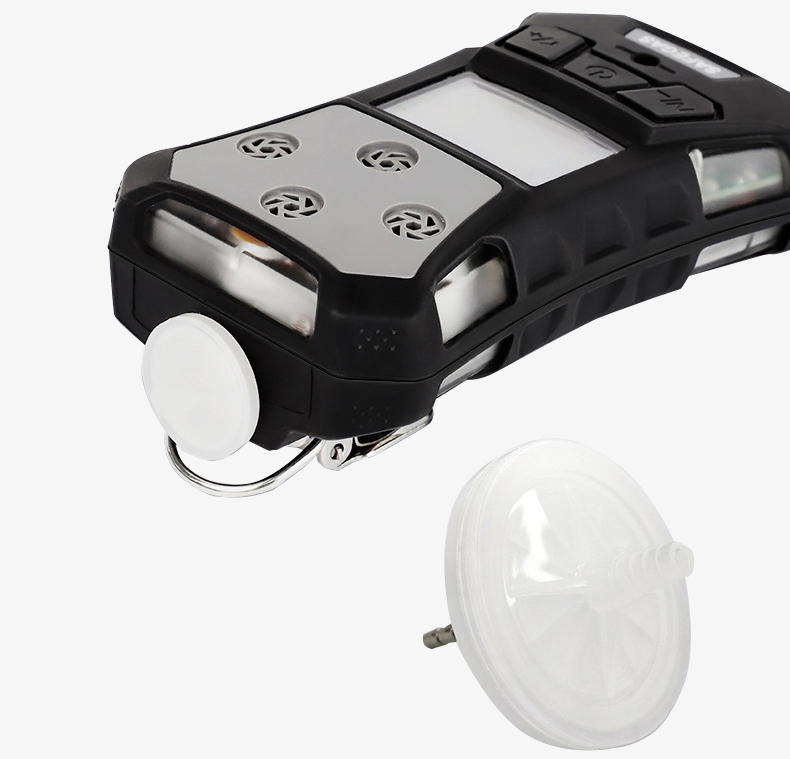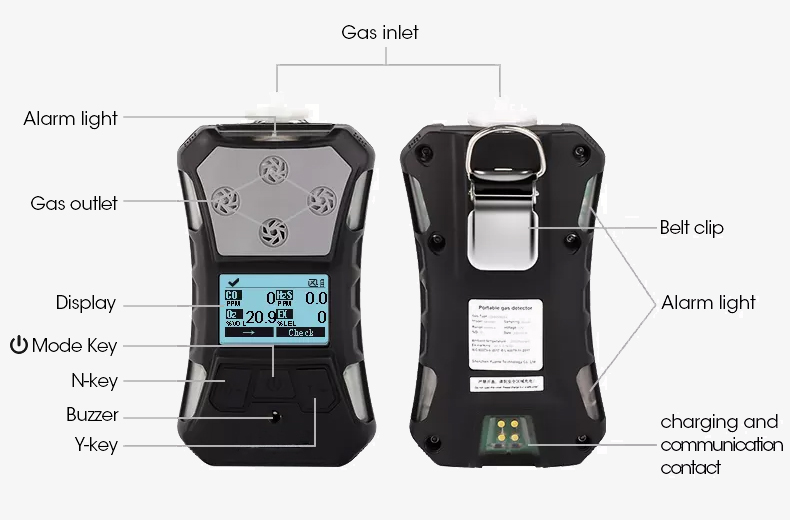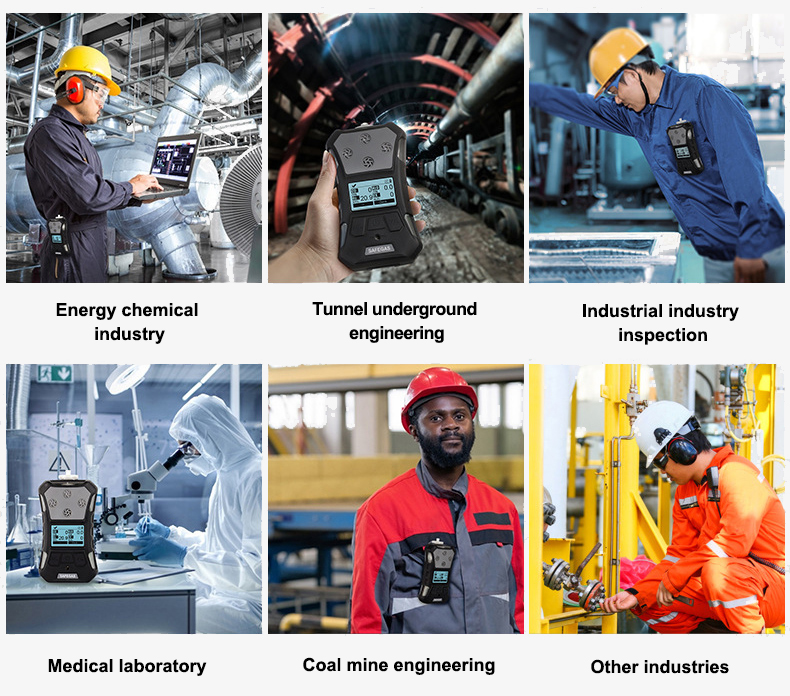High precision explosion-proof gas detector is a suction and diffusion dual-purpose device. When the air pump fails or is in a special emergency situation, portable gas detector can automatically switch to the diffusion sampling method, thereby improving the protection to a new level. Handheld detector is available with a VOC measuring range of 0 to 100 ppm, 0 to 500 ppm, 0 to 1000 ppm, and 0 to 5000 ppm.

Explosion-proof gas detector can detect 5 gases ( CO, H2S, O2, LEL, and VOC ) at the same time.
-
sisco portable explosion-proof gas detector has got IECEX, ATEX, explosion-proof certificates and the explosion-proof level reaches Exia IICT4 Ga.
-
Real-time value, TWA, STEL, MAX, MIN multiple numerical display, and the screen can be automatically turned 180 degrees, which is convenient for viewing in special operating environments.
-
The gas detector is equipped with a safety reminder function, sound and light vibration alarm function and high & low alarm latched function allowing the operator to better capture the sudden change of the gas concentration value.

Portable gas detector with built-in powerful sampling pump, fast detection speed.
- The explosion-proof gas detector can be connected 20m sampling tube externally, which is convenient for long-distance or confined space detection.
- With a water trap filter, the multi gas detector can effectively filter water, oil, dust and other impurities. It can also be used in harsh industrial environments such as coal mines and petroleum fields.
- Suction and diffusion dual-purpose device. Standard storage function, one-click data export, convenient for users to analyze.
- sisco portable gas detector is available with a unique modifiable ID identification function and automatic detection functions, automatic prompts for voltage, and pump failure alarms.
- The gas detector supports each channel sensor to restore the factory setting separately and multi-language including English, Chinese and etc.
Details

Applications

| Model | GD400-5GAS |
| Sampling method | Pump suction & diffusion dual-use type |
| Gas type | CO, H2S, O2, LEL, VOC |
| Measuring range | O2: 0-30%Vol, EX: 0-100%LEL, CO: 0-1000ppm, H2S: 0-100ppm, VOC: 0-100ppm, 0-200ppm, 0-500ppm, 0-1000ppm, 0-2000ppm, 0-5000ppm (Optional) |
| Resolution | Please contact us before placing an order. |
| Response time | ≤30 seconds |
| Precision | ≤±2%F.S except for special gases |
| Language | Chinese/English(More languages can be customized) |
| Automatically test and calibrate after power-on | Including reset, maximum value (MAX), minimum value (MIN), STEL, TWA value |
| Unit | PPM and mg/m3 can be switched and displayed by one key, and the concentration value is automatically converted by the system |
| Display | Monochrome graphics (160 x96) , screen can be automatically flipped |
| Backlight | The backlight time can be manually set and will be turned on automatically when an alarm is issued |
| Data record | Can store 100,000 sets data, the storage interval is adjustable from 5 to 3600 seconds, data can be exported, with data cable |
| Alarm | 95dB buzzer (@30cm), vibration alarm and flashing red LED and alarm status indication on the screen, alarm latched; diagnostic alarm and battery undervoltage alarm, pump block alarm; man down alarm, with early warning and optional real-time remote Bluetooth notification function |
| Battery | 3.7V rechargeable lithium battery, battery capacity 2200mA |
| Working hours | More than 15 hours in continuous pumping mode |
| Charger | Travel charger with DC interface, charging time ≥ 4 hours |
| Explosion-proof grade | ll 2G Ex ia ll CT4 Ga |
| Certification (EU regulations) |
CE, ATEX (Standard: EN IEC 60079-0:2018, EN 60079-1:2014) |
| Protection grade | IP67 |
| Working temperature | -20℃~+50℃ |
| Humidity | 0~90%RH(no condensation) |
| Environmental pressure | 86~106Kpa |
| Size | 157*84.5*59.5mm (including back clip/water trap filter) (length * width * height) |
| Weight | 365g (including battery, belt clip and filter) |
| Extension Probe | About 480mm (Total Length), About 300mm (Probe Head) |
| Package Included | 1 piece Gas detector, 1 piece 12V/1A DC power adapter, 1 piece USB cable, 1 piece User manual, 1 piece Warranty card, 1 piece Filter, 1 piece Aluminum suitcase |
Package List
- 1*Gas detector
- 1*12V/1A DC power adapter
- 1*USB cable
- 1*User manual
- 1*Warranty card
- 1*Filter
- 1*Aluminum suitcase
Gas Detector Catalog & User Manual
 SISCO Gas Detector Catalogue
SISCO Gas Detector Catalogue SISCO GD200 Portable Gas Detector User Manual
SISCO GD200 Portable Gas Detector User Manual SISCO GD300 Online Fixed Gas Detector User Manual
SISCO GD300 Online Fixed Gas Detector User Manual SISCO GD400 Explosion Proof Portable Gas Detector User Manual
SISCO GD400 Explosion Proof Portable Gas Detector User Manual SISCO GD500 Handheld Multi Gas Detector User Manual
SISCO GD500 Handheld Multi Gas Detector User Manual SISCO GD600 Multi Gas Analyzers User Manual
SISCO GD600 Multi Gas Analyzers User Manual SISCO Gas Detector Communication Protocol V1.0
SISCO Gas Detector Communication Protocol V1.0 SISCO Single Stage Pressure Regulator User Manual
SISCO Single Stage Pressure Regulator User Manual SISCO Gas Detector Data Downloading Operation Instruction
SISCO Gas Detector Data Downloading Operation Instruction
Gas Detector Software
Q1: What is a gas detector?
A1: A gas detector is an instrument for gas leakage concentration detection, including a portable gas detector, handheld gas detector, fixed gas detector, online gas detector, etc.
Q2: What does a gas detector detect?
A2: Combustible gases: Natural gas (methane), liquefied gas, coal gas (hydrogen), acetylene, pentane, alkynes, acetone, toluene, alcohols, hydrocarbons, light oil, etc.
Toxic gases: Carbon monoxide, hydrogen sulfide, ammonia, chlorine, oxygen, phosphine, sulfur dioxide, hydrogen chloride, chlorine dioxide and other toxic and harmful gases.
Q3: What is ppm of gas detector?
A3: Parts per million or "ppm" is often used as a fractional measure of concentration. For example, a methane (molecular) concentration of 2% means that 2 out of every 100 air molecules are methane. Likewise, a methane concentration of 2 ppm means that 2 out of every 1 million air molecules are methane.
Tips: Tips for using sisco portable explosion-proof gas detector
Any gas detector has a fixed detection range, and the measurement can only be completed within this range, otherwise, the measured result is much lower than the value of your environment. In addition, measuring over the range for a long time will cause damage to the sensor, so the correct result cannot be obtained in the measurement range later.
sisco gas detectors have a limited service life. Even if they are not used frequently, they will still experience aging. In general, among the portable gas detectors, the photoionization detector has the longest lifespan of about four years; the lifespan of the LEL sensor is the second, which can be used for more than three years; the lifespan of the electrochemical-specific gas sensor is relatively short, generally within one to two years; the oxygen sensor can only be used for about one year.
Therefore, be sure to read the instruction carefully before using a portable gas detector, and use it within the validity period of the sensor. If it is found to be expired, it needs to be replaced immediately. The detector needs to be calibrated and tested frequently.
Thank you for buying industrial test and measurement equipment on SISCO.com, all products sold by SISCO and the partner cover a 12 months warranty, effective from the date of receiving the products.
What is covered?
SISCO is responsible for providing free spare parts, and free technical support to assist the customer to repair the defective products until the problem is solved.
What is not covered?
- Product purchased from anyone other than a SISCO store or a SISCO authorized reseller.
- Expendable parts.
- Routine cleaning or normal cosmetic and mechanical wear.
- Damage from misuse, abuse or neglect.
- Damage from use of parts other than SISCO approved.
- Damage from use outside the product’s usage or storage parameters.
- Damage from use of parts not sold by SISCO.
- Damage from modification or incorporation into other products.
- Damage from repair or replacement of warranted parts by a service provider other than a SISCO authorized service provider.
- Damage caused by the application environment not meeting the product usage requirements and the failure to perform preventive maintenance.

